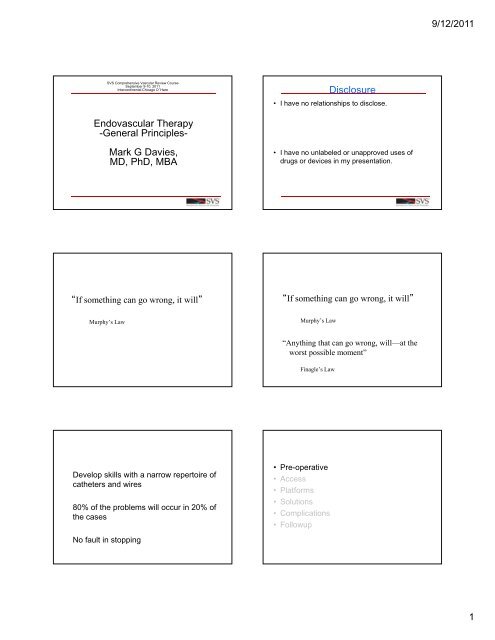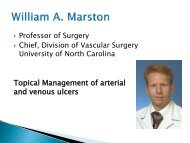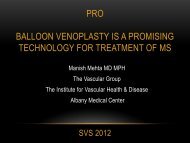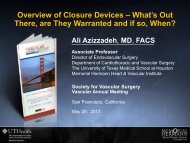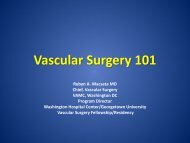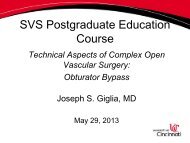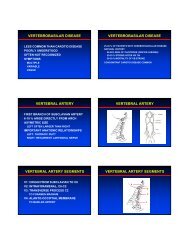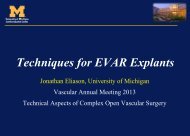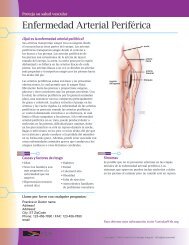General Principles - VascularWeb
General Principles - VascularWeb
General Principles - VascularWeb
Create successful ePaper yourself
Turn your PDF publications into a flip-book with our unique Google optimized e-Paper software.
9/12/2011<br />
SVS Comprehensive Vascular Review Course<br />
September 9-10, 2011<br />
Intercontinental Chicago O’Hare<br />
Disclosure<br />
• I have no relationships to disclose.<br />
Endovascular Therapy<br />
-<strong>General</strong> <strong>Principles</strong>-<br />
Mark G Davies,<br />
MD, PhD, MBA<br />
• I have no unlabeled or unapproved uses of<br />
drugs or devices in my presentation.<br />
“If something can go wrong, it will”<br />
“If something can go wrong, it will”<br />
Murphy’s Law<br />
Murphy’s Law<br />
“Anything that can go wrong, will—at the<br />
worst possible moment”<br />
Finagle’s Law<br />
Develop skills with a narrow repertoire of<br />
catheters and wires<br />
80% of the problems will occur in 20% of<br />
the cases<br />
No fault in stopping<br />
• Pre-operative<br />
• Access<br />
• Platforms<br />
• Solutions<br />
• Complications<br />
• Followup<br />
1
9/12/2011<br />
• Pre-operative Imaging<br />
– CTA or MRA<br />
– Echolucency<br />
– Atherosclerosis vs. clot<br />
• Better access<br />
• Choice and availability of Platforms<br />
• Reduction in Radiation and Contrast<br />
A<br />
Supra-Renal<br />
Aorta<br />
Renal Arteries<br />
Iliac Arteries<br />
Aorto-Iliac<br />
Runoff<br />
Infra-Renal<br />
Aorta<br />
Femoral<br />
Arteries<br />
B<br />
CFA<br />
Femoro-popliteal<br />
Runoff<br />
C<br />
Popliteal<br />
Tibial Vessel<br />
runoff<br />
SFA<br />
Tibial<br />
Vessels<br />
Popliteal<br />
Pedal<br />
Vessels<br />
• Pre-operative Pharmacology<br />
– ASA, Plavix<br />
– Statins<br />
– Normal Saline<br />
• Mucomyst<br />
• Bicarbonate<br />
– Antibiotics<br />
2
9/12/2011<br />
• Pre-operative<br />
• Access<br />
• Platforms<br />
• Solutions<br />
• Complications<br />
– Prevention<br />
– Correcting<br />
• Followup<br />
Deep circumflex<br />
iliac<br />
Inferior<br />
epigastric<br />
CFA<br />
PFA<br />
SFA<br />
21 GA<br />
• Ultrasound access<br />
• Micropunctures kits<br />
• Direction<br />
– Retrograde Iliac<br />
– Antegrade UE<br />
– Antegrade LE<br />
– Retrograde Pop or Tibial ( DP or PT)<br />
• Length and redundancy<br />
3
9/12/2011<br />
Femoral Arterial Access With Ultrasound<br />
Trial [FAUST]<br />
• Routine real-time US guidance improved<br />
CFA cannulation only in patients with high<br />
CFA bifurcations but reduced the number<br />
of attempts, time to access, risk of<br />
venipunctures, and vascular complications<br />
in femoral arterial access<br />
Seto AH, Abu-Fadel MS, Sparling JM, Zacharias SJ, Daly TS, Harrison AT, Suh WM, Vera JA, Aston CE, Winters RJ, Patel PM,<br />
Hennebry TA, Kern MJ. Real-time ultrasound guidance facilitates femoral arterial access and reduces vascular complications: FAUST<br />
(Femoral Arterial Access With Ultrasound Trial). JACC Cardiovasc Interv. 2010 Jul;3(7):751-8.<br />
• Vascular complications associated with arterial access are<br />
recognized to occur during cardiac catheterization and<br />
percutaneous intervention procedures<br />
• Reported complication rates
9/12/2011<br />
• Pre-operative<br />
• Access<br />
• Platforms<br />
• Solutions<br />
• Complications<br />
– Prevention<br />
– Correcting<br />
• Followup<br />
• Wire<br />
– 0.035<br />
– 0.018<br />
– 0.014<br />
• Sheath<br />
–4Fr<br />
–5Fr<br />
–6Fr<br />
• Guide<br />
– 4Fr systems<br />
• Delivery<br />
–OTW<br />
– Monorail<br />
• Leading edge<br />
• Shaft strength<br />
Guidewires<br />
Wire Component<br />
• Wire tip<br />
• Mandrel<br />
• Cover<br />
28<br />
Wire Characteristics<br />
• Length<br />
• Thickness<br />
• Tip design<br />
• Stiffness<br />
• Hydrophilic coating<br />
• Unseen and Unguided Wire = Dissection<br />
• Push back on the wire = Dissection<br />
• Right of the Spine = Venous Stick<br />
• Lateral of the femur = Profunda<br />
29<br />
5
9/12/2011<br />
Torque Devices<br />
Catheters<br />
• Probe lesions<br />
• Avoid buckling or coiling<br />
the wire proximal to lesion<br />
• Platinum tips will deform<br />
and kink<br />
“Work the Wire!”<br />
Characteristics<br />
• Tip design<br />
• Stiffness<br />
• Tourqability<br />
• Hydrophilic coating<br />
• Radio‐opacity<br />
• Length<br />
• Diameter<br />
• Hole(s)<br />
Length<br />
• Depends of the distance of the work area<br />
from the access site<br />
• Short catheters (60‐65 cm), usually sued for<br />
iliac work or with antegrade femoral access.<br />
• Intermediate catheters (90‐110 cm) for<br />
contralateral femoral or popliteal work or<br />
carotid artery work<br />
• Long catheters (130‐150 cm) for contralateral<br />
tibial artery work<br />
33<br />
34<br />
• Bown MJ, Bolia A, Sutton AJ. Subintimal<br />
angioplasty: meta‐analytical evidence of<br />
clinical utility. Eur J Vasc Endovasc Surg.<br />
2009 Sep;38(3):323‐37.<br />
• Pooled estimates<br />
– technical success: 85.7%<br />
• (95% confidence interval: 83.3%‐87.7%, 2810 limbs),<br />
– primary patency at 12 months : 55.8%<br />
• (95% confidence interval: 47.9%‐63.4%, 1342 limbs)<br />
– limb salvage at 12 months: 89.3%<br />
• (95% confidence interval: 85.5%‐92.2%, 2810 limbs),<br />
6
9/12/2011<br />
Catheter diameter<br />
• Equal to the outer circumference of the<br />
catheter (French size)<br />
• Catheter size determines the wire size<br />
that can be used with it:<br />
– 2 –3 French use 0.018 or 0.014 inch wires<br />
– 4 –5 French use 0.035 or 0.038 inch wires<br />
• Larger sizes catheters are usually used<br />
as guiding catheters.<br />
37<br />
• Integrated dilator<br />
• Hemostatic valve<br />
• Side port<br />
• The size is the size of<br />
the lumen<br />
• 1 French size = 3.3mm<br />
Sheath<br />
38<br />
Guiding Catheters<br />
• Dilator is not always<br />
integrated<br />
• No hemostatic valve at the<br />
hub<br />
• Needs a hemostatic<br />
component e.g. Touhy‐Borst<br />
• The size is the outer<br />
circumference<br />
39<br />
• Pre-operative<br />
• Access<br />
• Platforms<br />
• Solutions<br />
• Complications<br />
– Prevention<br />
– Correcting<br />
• Followup<br />
• Balloons<br />
– 0.035<br />
– 0.018<br />
– 0.014<br />
• Pressure<br />
• Length<br />
• Conformable<br />
• Other Balloons<br />
–Cryo<br />
–Ultra HP<br />
– Cutting<br />
• Stents<br />
– Regular<br />
– Closed Cell<br />
–Flexible<br />
– Covered<br />
– Biodegradable<br />
• Atherectomy<br />
– Directional<br />
– Rotational<br />
– Remote<br />
endarterectomy<br />
• Laser<br />
7
9/12/2011<br />
Angioplasty Balloons<br />
44<br />
Balloon Angioplasty<br />
• Remains the most effective and widely used<br />
percutaneous technique<br />
• Controlled stretch injury:<br />
– Desquamation of endothelial cells<br />
– Splitting or dissection of plaque and intima<br />
– Stretching of the media<br />
– Platelets and fibrin cover the denuded area<br />
– Intima reendothelializes, artery remodels<br />
– If intimal healing is prolific, restenosis occurs<br />
Balloon Characteristics<br />
• Size<br />
• Platform size<br />
• Profile<br />
• Pushability<br />
• Tractability<br />
• Pressure rating<br />
• Compliance<br />
46<br />
• Sachs T, Pomposelli F, Hamdan A, Wyers M,<br />
Schermerhorn M. Trends in the national<br />
outcomes and costs for claudication and<br />
limb threatening ischemia: Angioplasty vs<br />
bypass graft.J Vasc Surg. 2011 Aug 29. [Epub<br />
ahead of print]<br />
• Mortality is slightly lower with PTA for all<br />
indications, amputation rates for limb‐threat<br />
patients appear higher, as does the average<br />
cost<br />
• E Y, He N, Wang Y, Fan H. Percutaneous<br />
transluminal angioplasty (PTA) alone<br />
versus PTA with balloon‐expandable stent<br />
placement for short‐segment<br />
femoropopliteal artery disease: a<br />
metaanalysis of randomized trials. J Vasc<br />
Interv Radiol. 2008 Apr;19(4):499‐503.<br />
• In the treatment of femoropopliteal artery<br />
occlusive disease (< or =10 cm), higher<br />
primary patency rates can be expected at 6<br />
months with PTA followed by implantation<br />
of balloon‐expandable stents versus PTA<br />
alone<br />
8
9/12/2011<br />
• Mwipatayi BP, Hockings A, Hofmann M,<br />
Garbowski M, Sieunarine K. Balloon<br />
angioplasty compared with stenting for<br />
treatment of femoropopliteal occlusive<br />
disease: a meta‐analysis. J Vasc Surg. 2008<br />
Feb;47(2):461‐9<br />
• Stent placement in the femoropopliteal<br />
occlusive disease does not increase the<br />
patency rate when compared with<br />
angioplasty alone at 1 year.<br />
• CochTwine CP, Coulston J, Shandall A,<br />
McLain ADAngioplasty versus stenting for<br />
superficial femoral artery lesions. rane<br />
Database Syst Rev. 2009 Apr 15;(2):CD006767.<br />
• There is limited benefit to stenting lesions of<br />
the superficial femoral artery in addition to<br />
angioplasty.<br />
Specialty Balloons<br />
• Cryoplasty Balloons<br />
• Cutting Balloons<br />
• Scoring Balloons<br />
Cryoplasty Balloons<br />
• The PolarCath (Boston<br />
Scientific)<br />
• Employs cold therapy<br />
using nitrous oxide as<br />
the inflation material<br />
• The concept of inducing<br />
apoptosis via freezing<br />
to reduce intimal<br />
hyperplastic response<br />
51<br />
52<br />
• Lyden SP. Indications and results with<br />
cryoplasty in the treatment of infrainguinal<br />
arterial occlusive disease. Vascular. 2006<br />
Sep‐Oct;14(5):290‐6.<br />
• Cryoplasty yappears to improve patency over<br />
conventional angioplasty and to reduce the<br />
need for bailout stenting in femoropopliteal<br />
stenoses and occlusions < 10 cm in length.<br />
• Cutting Balloon<br />
(Boston Scientific).<br />
• The device has four<br />
longitudinal<br />
microsurgical blades<br />
attached to the<br />
balloon (atherotomes)<br />
• Allow for more<br />
controlled fracture<br />
and dilation of the<br />
vessel<br />
Cutting Balloons<br />
54<br />
9
9/12/2011<br />
• Angiosculpt<br />
(AngioScore, fremont,<br />
CA)<br />
• Similar to cutting<br />
balloons but instead of<br />
atherotomes, it uses a<br />
flexible nitinol scoring<br />
element with three<br />
rectangular spiral struts<br />
Scoring Balloons<br />
• Canaud L, Alric P, Berthet JP, Marty‐Ané C,<br />
Mercier G, Branchereau P. Infrainguinal<br />
cutting balloon angioplasty in de novo<br />
arterial lesions. J Vasc Surg. 2008<br />
Nov;48(5):1182‐8.<br />
• CB‐PTA is safe and feasible for the treatment<br />
of infrainguinal arterial occlusive disease,<br />
with relatively low mid‐term restenosis rates<br />
compared to other endovascular treatments<br />
• Lesions
9/12/2011<br />
Stents<br />
• It is said that the term Stent originated<br />
from Charles R Stent, a 19 th century<br />
British Dentist naming a dental<br />
apparatus used form making molds<br />
“Stent”<br />
• Dotter was the first to apply metallic<br />
stents to the human vascular tree.<br />
61<br />
• High radial force<br />
• Resistant to recoil<br />
• Minimal or no<br />
stimulation of intimal<br />
hyperplasia<br />
• Longitudinal<br />
flexibility<br />
• High radiopacity for<br />
visualization<br />
• Ability to conform to<br />
Ideal Stent<br />
• Low profile<br />
• Minimal or no<br />
foreshortening<br />
• Easy deployment<br />
system<br />
• Maintenance of side<br />
branch patency<br />
• Magnetic resonance<br />
imaging compatibility<br />
• Durability<br />
• Low price<br />
the vessel<br />
62<br />
Balloon Expanding<br />
Stent Types<br />
• Mechanism of deployment<br />
– Self‐Expanding stents<br />
– Balloon‐Expanding stents.<br />
• Bare metal stents or Covered stents<br />
(stent grafts)<br />
• Special types of stents<br />
– Drug eluting stents<br />
– Bio‐degradable stents<br />
Pros<br />
Balloon Expandable vs<br />
Self Expanding<br />
Balloon Expandable Stents Self Expanding Stents<br />
Accurate deployment<br />
Strong radial force<br />
Radio-opaque<br />
Flexible<br />
Long<br />
Crush resistant<br />
Cons<br />
Rigidid Insufficient i radial force<br />
Short<br />
Insufficient radio-opacity<br />
Crushable<br />
Less accurate deployment<br />
Uses<br />
Orificial lesions<br />
Calcific lesions<br />
Resistant lesions<br />
Superficial lesions<br />
Long lesions<br />
Tortuous lesions<br />
63<br />
64<br />
Balloon Expandable Stents<br />
• Slotted malleable<br />
metal tubes expanded<br />
by a coaxial balloon<br />
matched to target<br />
vessel diameter<br />
• Most are made of<br />
stainless steel alloy<br />
Self Expanding Stents<br />
• Have a natural shape that is based on<br />
their mechanical or thermo‐mechanical<br />
properties.<br />
• Walstents are the prototype of the<br />
mechanical self expanding stents.<br />
• Nitinol stents are the prototype of the<br />
thermo‐mechanical stents.<br />
66<br />
11
9/12/2011<br />
Nitinol Stents<br />
• Nickel and titanium alloy (50‐55% Nickel –<br />
45‐50% Titanium).<br />
• It possesses thermal memory<br />
• Memory is set at high temperature (1,000° F)<br />
• At the transition point (90° F) the alloy<br />
regains its shape<br />
• Below the transition point, the metal is pliable<br />
Nitinol Stents<br />
Lifestent<br />
67<br />
Nitinol Stent Implantation Versus Balloon<br />
Angioplasty for Lesions in the Superficial Femoral<br />
Artery and Proximal Popliteal Artery - Twelve-Month<br />
Results From the RESILIENT Randomized Trial<br />
• At 12 months, freedom from target lesion<br />
revascularization was 87.3% for the stent group<br />
compared with 45.1% for the angioplasty group<br />
(P
9/12/2011<br />
Covered Stents<br />
• "ideal indications" for stent graft<br />
– segments with a length of ≥1 cm proximal and<br />
distal without any obstruction,<br />
– no lesions in the popliteal artery<br />
– one open tibial vessel<br />
– no severe calcifications<br />
– adequate antiplatelet therapy or<br />
anticoagulation),<br />
• McQuade K, Gable D, Pearl G, Theune B, Black S.<br />
Four-year randomized prospective comparison of<br />
percutaneous ePTFE/nitinol self-expanding stent<br />
graft versus prosthetic femoral-popliteal bypass in<br />
the treatment of superficial femoral artery<br />
occlusive diseaseJ Vasc Surg. 2010 Sep;52(3):584-<br />
90; discussion 590-1, 591.e1-591.e7.<br />
• Management of superficial femoral artery<br />
occlusive disease with percutaneous stent<br />
grafts exhibits similar primary patency at 4-year<br />
(48 month) follow up when compared with<br />
conventional femoral-popliteal artery bypass<br />
grafting with synthetic conduit<br />
To debulk or not…<br />
Device Advantages Limitations<br />
Famiarity to IC<br />
Effective with calcium<br />
Heat Generation<br />
Larger particle sizes than OA<br />
• Rotational<br />
• Excimer Laser<br />
• Directional<br />
Atherectomy<br />
• Orbital Atherectomy<br />
• Pathway Athectomy<br />
No wire exchange<br />
Eliminates thrombus<br />
Effective on soft plaque<br />
Challenged with Calciuc<br />
Effective on calcium<br />
Lumen size varies by<br />
speed of rotation<br />
Aspiration included<br />
Blades up increases lumen<br />
size<br />
Limited with calcium<br />
Contact ablation only<br />
Distal embolization risk<br />
Prolonged procedure time<br />
Potential for complications with poor<br />
technique or large crown size<br />
Unable to treat
9/12/2011<br />
• Distal Embolization<br />
– Emboli occur during wire crossing,<br />
angioplasty, stent deployment and<br />
atherectomy<br />
– 55% of patients can be shown to have<br />
macroembolism (PROTECT registry)<br />
– ~1% have been reported to result in<br />
angiographic loss of runoff<br />
• Distal Embolization<br />
– PROTECT registry angiographic criteria:<br />
• moderate or severe calcification of any length<br />
• total occlusions of any length<br />
• a filling defect<br />
• irregular (ulcerated) lesions at least 30 mm in<br />
length,<br />
• smooth, non-ulcerated lesions at least 50 mm<br />
in length<br />
– Collected particles consisted primarily of<br />
platelets and fibrin conglomerates, trapped<br />
erythrocytes, inflammatory cells, and<br />
extracellular matrix<br />
Incidence<br />
Processes Leading to Restenosis<br />
In situ<br />
Thrombosis<br />
Distal<br />
Embolization<br />
3.5% 3.8%<br />
• Pre-operative<br />
• Access<br />
• Platforms<br />
• Solutions<br />
• Complications<br />
– Prevention<br />
– Correcting<br />
• Follow up<br />
14
9/12/2011<br />
Reporting Standards<br />
• Primary Patency<br />
• Assisted Primary<br />
Patency<br />
• Secondary Patency<br />
• Survival<br />
• Limb Salvage<br />
• Target Lesion<br />
Revascularization<br />
• Target Extremity<br />
Revascularization<br />
• Symptom Free<br />
• Clinical Efficacy<br />
• Amputation Free<br />
Survival<br />
• MACE, MALE, 30d<br />
Amp<br />
• “Keep it simple”<br />
• “Do not do the economic patient”<br />
• “Do not attempt the impossible!”<br />
• “First, do no harm”<br />
• “If Plan A does not work, do not try plan A<br />
again”<br />
• “There is always bypass”<br />
15


